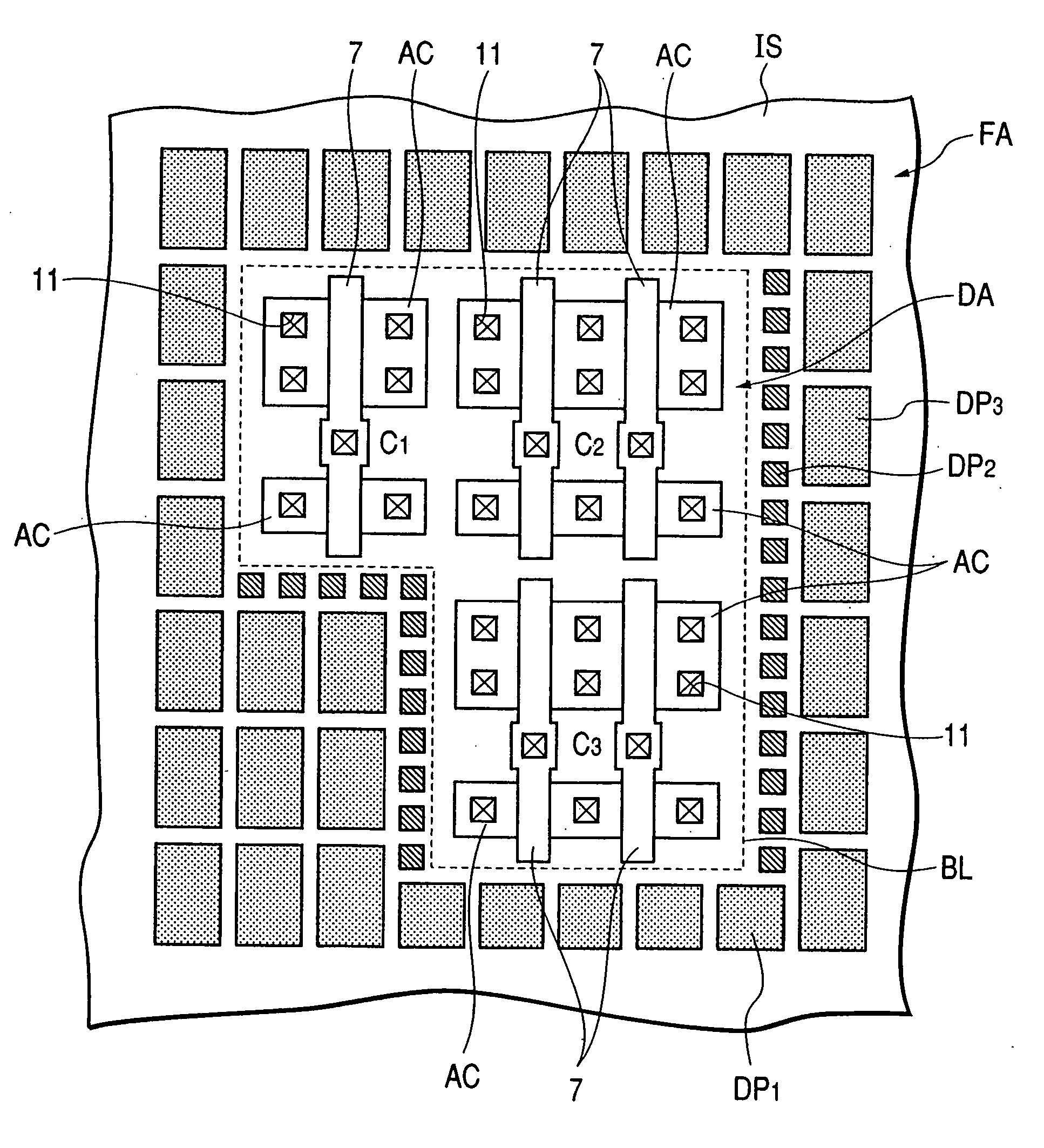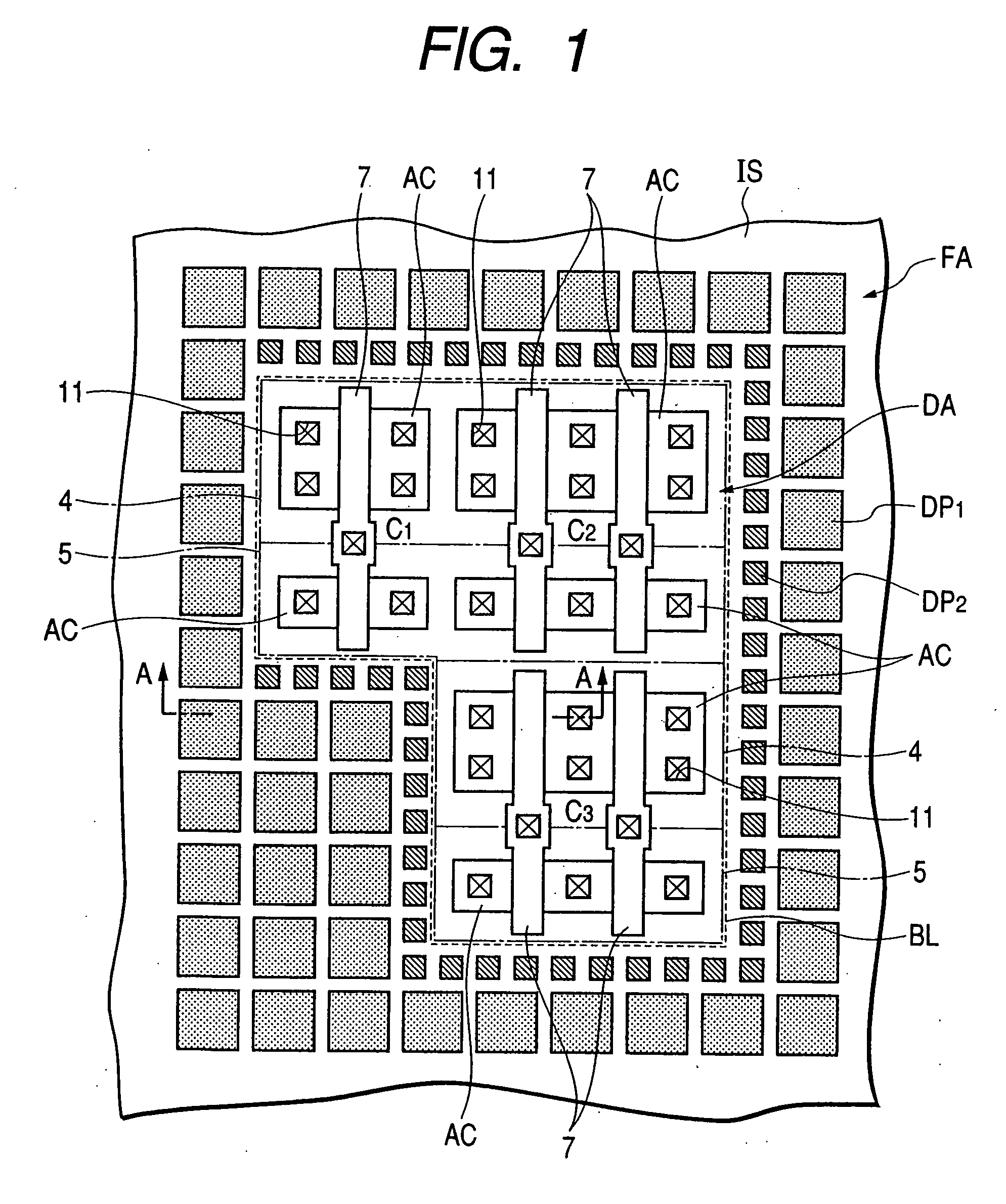Semiconductor device and a method of manufacturing the same and designing the same
a technology of semiconductor devices and dummy structures, applied in semiconductor devices, semiconductor/solid-state device details, electrical apparatus, etc., can solve the problems of complex shape of dummy structures and imperfect insulation films, and achieve the effect of improving the flatness of the surface of the insulation film embedded in the isolation groove, increasing the number of dummy patterns, and increasing the amount of coordinate data
- Summary
- Abstract
- Description
- Claims
- Application Information
AI Technical Summary
Benefits of technology
Problems solved by technology
Method used
Image
Examples
embodiment 1
[0057] An example of the placement of dummy patterns according to embodiment 1 of the present invention will be explained with reference to FIG. 1 to FIG. 5. FIG. 1 is a plan view of an example of a logic integrated circuit device. FIG. 2 is a cross-sectional view taken along the line A-A of FIG. 1. FIGS. 3(a) and 3(b) are plan views showing a pitch and a size of the dummy patterns. FIG. 4 is a plan view showing an example of the placement of the dummy patterns. FIG. 5 is a process flow diagram showing an example of a method of generating the dummy patterns.
[0058] As shown in FIG. 1, the area inside of the boundary BL, which is indicated by a broken line, represents the element forming region DA where semiconductor elements are formed, while the area outside of the boundary BL represents the dummy region FA where semiconductor elements are not formed.
[0059] The boundary BL between the element forming region DA and dummy region FA is determined from a layout of the conductive film ...
embodiment 2
[0090] The embodiment 2 of the present invention is directed to another manufacturing method that can be used to form the structure of FIG. 1.
[0091]FIG. 17 and FIG. 18, which illustrate the embodiment 2, are cross-sectional views of a portion of a semiconductor substrate after completion of the manufacturing processes explained with reference to FIGS. 6 and 7.
[0092] In this embodiment, the isolation grooves 2, 2a are formed first to a depth of about 0.3 to 0.4 μm on the semiconductor substrate 1, and then the silicon oxide film 3 is deposited on the semiconductor substrate 1 using the CVD method or plasma CVD method.
[0093] Next, as shown in FIG. 17, a coated insulation film 18, for example, an SOG (Spin On Glass) film, is formed as the upper layer of the silicon oxide film 3. This coated insulation film 18 can be flattened at its surface even when a fine level-difference exists due to the fluidity of the film. Therefore, even if a recess is generated at the surface of the silicon...
embodiment 3
[0097] The embodiment 3 is directed to another manufacturing method that can be used to form the structure of FIG. 1, and this embodiment will be explained with reference to FIG. 19 to FIG. 22.
[0098] First, as shown in FIG. 19, a semiconductor substrate 1, consisting, for example, of a p-type single crystal silicon, is subjected to the thermal oxidation to form on the surface thereof a gate insulation film 19 consisting of a thin silicon oxide film having a thickness of about 2 to 3 nm. Next, a first silicon film 20 having a thickness of about 50 nm and a silicon nitride film having a thickness of about 120 to 200 nm are deposited sequentially as upper layers using the CVD method. Thereafter, the silicon nitride film 21, first silicon film 20 and gate insulation film 19 are sequentially dry-etched using a resist pattern as a mask. The first silicon film 20 is composed of a non-crystal silicon or polycrystalline silicon. Subsequently, after the resist pattern is removed, the isolati...
PUM
 Login to View More
Login to View More Abstract
Description
Claims
Application Information
 Login to View More
Login to View More - R&D
- Intellectual Property
- Life Sciences
- Materials
- Tech Scout
- Unparalleled Data Quality
- Higher Quality Content
- 60% Fewer Hallucinations
Browse by: Latest US Patents, China's latest patents, Technical Efficacy Thesaurus, Application Domain, Technology Topic, Popular Technical Reports.
© 2025 PatSnap. All rights reserved.Legal|Privacy policy|Modern Slavery Act Transparency Statement|Sitemap|About US| Contact US: help@patsnap.com



